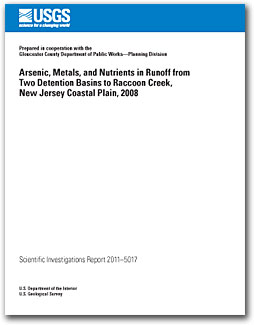Scientific Investigations Report 2011–5017
ABSTRACT
Arsenic (As) concentrations in the waters of Raccoon Creek in southern New Jersey commonly exceed the State's Surface Water Quality Standard (SWQS) for freshwater of 0.017 microgram per liter (µg/L). In order to assess contributions of As from residential runoff to the creek, samples of runoff water were collected from a detention basin in each of two residential developments underlain by different geologic formations and at the outlets of those basins. Samples of streamwater also were collected from Raccoon Creek adjacent to the developments. The samples were analyzed to determine concentrations of As, selected metals, organic carbon, and nutrients. Soil samples in and downgradient from the basins also were collected and analyzed. Concentrations of As in unfiltered water samples of runoff from the basin underlain by glauconitic clays generally were higher (up to 4.35 µg/L) than in runoff from the basin underlain by predominantly quartz sands and silts (up to 2.68 µg/L). Chromium (Cr) concentrations also were higher in runoff from the basin underlain by glauconitic clays than in runoff from the basin underlain by quartz sand and silt. In addition, Cr concentrations were higher in the glauconitic soils than in the quartz-rich soils. Metals such as aluminum (Al), iron (Fe), lead (Pb), and manganese (Mn) in the runoff and in the streamwater were mostly in particulate form. Arsenic, most metals, and phosphorus (P) however, were mostly in dissolved form in runoff but in particulate form in the streamwater. Total organic carbon concentrations in the runoff ranged from about 10 to nearly 16 milligrams per liter (mg/L). Given such levels of organic carbon and strong correlations between concentrations of some metals and organic carbon, it may be that many of the metals were complexed with dissolved organic carbon and transported in that form in the runoff. Although underlying geologic materials and soils appear to be major contributors of As to the streamwater, As also could have been contributed from lead arsenate pesticide residues. The residential development underlain by quartz-rich sediments formerly had been an orchard where such pesticides may have been used. The substantial inputs of As to runoff at this site may be attributable to this former land use, although Pb concentrations were about the same in runoff from both sites. The streamwater at both sites, however, contained Pb concentrations well above those in runoff, indicating that there are additional inputs of Pb, perhaps from roadside soils, upstream from the two sampling sites in this study. Positive relations between concentrations of As and some metals with dissolved organic carbon in runoff and streamwater indicate that complexation with organic carbon may provide a mechanism by which these constituents can be transported. Sorption of As, Pb, and P to Fe hydroxides may be indicated by the observed positive relation of particulate As, Pb, and P to particulate Fe, however, representing an additional mechanism for transport of these constituents. |
First posted June 14, 2011 For additional information contact: Part or all of this report is presented in Portable Document Format (PDF); the latest version of Adobe Reader or similar software is required to view it. Download the latest version of Adobe Reader, free of charge. |
Barringer, J.L., Szabo, Zoltan, Bonin, J.L., and McGee, C.K., 2011, Arsenic, metals, and nutrients in runoff from two detention basins to Raccoon Creek, New Jersey Coastal Plain, 2008: U.S. Geological Survey Scientific Investigations Report 2011-5017, 28 p.
Abstract
Introduction
Purpose and Scope
Description of Study Area
Geology, Soils, and Streamwater Chemistry
Land Use
Methods
Collection of Water Samples
Collection of Soil Samples
Analysis of Samples
Streamflow Measurements
Quality-Assurance Measures
Arsenic, Metals, and Nutrients in Streamwater and in Runoff at Two Detention Basins
Estates 1
Estates 2
Differences in Water Chemistry, Estates 1 and 2, September 2008
Arsenic and Metals in Soils at and near Two Detention Basins
Estates 1
Estates 2
Possible Sources and Transport of Arsenic, Metals, and Nutrients to the Basins and Stream
Summary and Conclusions
Acknowledgments
References Cited
Appendix 1. Major and trace elements, organic carbon, and nutrients in water samples from two detention basins and their outfalls, at Estates 1 and 2, and from Raccoon Creek immediately upstream from the outfalls, Gloucester County, New Jersey, May and September 2008
Appendix 2. Major and trace elements in soils and sediments from Estates 1 and 2, Gloucester County, New Jersey, June-October, 2008